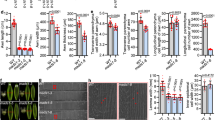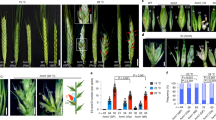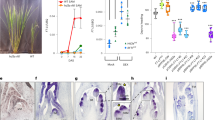Abstract
Plant architecture has clear agronomic and economic implications for crops such as wheat and barley, as it is a critical factor for determining grain yield. Despite this, only limited molecular information is available about how grain-bearing inflorescences, called spikes, are formed and maintain their regular, distichous pattern. Here we elucidate the molecular and hormonal role of Six-rowed spike 2 (Vrs2), which encodes a SHORT INTERNODES (SHI) transcriptional regulator during barley inflorescence and shoot development. We show that Vrs2 is specifically involved in floral organ patterning and phase duration by maintaining hormonal homeostasis and gradients during normal spike development and similarly influences plant stature traits. Furthermore, we establish a link between the SHI protein family and sucrose metabolism during organ growth and development that may have implications for deeper molecular insights into inflorescence and plant architecture in crops.
This is a preview of subscription content, access via your institution
Access options
Subscribe to this journal
Receive 12 print issues and online access
$209.00 per year
only $17.42 per issue
Buy this article
- Purchase on Springer Link
- Instant access to full article PDF
Prices may be subject to local taxes which are calculated during checkout





Similar content being viewed by others
References
Gaillochet, C., Daum, G. & Lohmann, J.U.O. O cell, where art thou? The mechanisms of shoot meristem patterning. Curr. Opin. Plant Biol. 23, 91–97 (2015).
Zhang, D.B. & Yuan, Z. in Annual Review of Plant Biology Vol. 65 (ed. Merchant, S.S.) 553–578 (Annual Reviews, 2014).
Pourkheirandish, M. & Komatsuda, T. The importance of barley genetics and domestication in a global perspective. Ann. Bot. 100, 999–1008 (2007).
Ramsay, L. et al. INTERMEDIUM-C, a modifier of lateral spikelet fertility in barley, is an ortholog of the maize domestication gene TEOSINTE BRANCHED 1. Nat. Genet. 43, 169–172 (2011).
Koppolu, R. et al. Six-rowed spike4 (vrs4) controls spikelet determinacy and row-type in barley. Proc. Natl. Acad. Sci. USA 110, 13198–13203 (2013).
Druka, A. et al. Genetic dissection of barley morphology and development. Plant Physiol. 155, 617–627 (2011).
Matsoukas, I.G. Interplay between sugar and hormone signaling pathways modulate floral signal transduction. Front. Genet. 5, 218 (2014).
Su, Y.-H., Liu, Y.-B. & Zhang, X.-S. Auxin–cytokinin interaction regulates meristem development. Mol. Plant 4, 616–625 (2011).
Nordström, A. et al. Auxin regulation of cytokinin biosynthesis in Arabidopsis thaliana: a factor of potential importance for auxin-cytokinin-regulated development. Proc. Natl. Acad. Sci. USA 101, 8039–8044 (2004).
King, R.W. et al. Regulation of flowering in the long-day grass Lolium temulentum by gibberellins and the FLOWERING LOCUS T gene. Plant Physiol. 141, 498–507 (2006).
Boden, S.A. et al. EARLY FLOWERING3 regulates flowering in spring barley by mediating gibberellin production and FLOWERING LOCUS T expression. Plant Cell 26, 1557–1569 (2014).
Eklund, D.M. et al. Homologues of the Arabidopsis thaliana SHI/STY/LRP1 genes control auxin biosynthesis and affect growth and development in the moss Physcomitrella patens. Development 137, 1275–1284 (2010).
Eklund, D.M. et al. The Arabidopsis thaliana STYLISH1 protein acts as a transcriptional activator regulating auxin biosynthesis. Plant Cell 22, 349–363 (2010).
Kuusk, S., Sohlberg, J.J., Magnus Eklund, D. & Sundberg, E. Functionally redundant SHI family genes regulate Arabidopsis gynoecium development in a dose-dependent manner. Plant J. 47, 99–111 (2006).
Fridborg, I., Kuusk, S., Robertson, M. & Sundberg, E. The Arabidopsis protein SHI represses gibberellin responses in Arabidopsis and barley. Plant Physiol. 127, 937–948 (2001).
Ståldal, V. et al. The Arabidopsis thaliana transcriptional activator STYLISH1 regulates genes affecting stamen development, cell expansion and timing of flowering. Plant Mol. Biol. 78, 545–559 (2012).
Baylis, T., Cierlik, I., Sundberg, E. & Mattsson, J. SHORT INTERNODES/STYLISH genes, regulators of auxin biosynthesis, are involved in leaf vein development in Arabidopsis thaliana. New Phytol. 197, 737–750 (2013).
Yuo, T. et al. A SHORT INTERNODES (SHI) family transcription factor gene regulates awn elongation and pistil morphology in barley. J. Exp. Bot. 63, 5223–5232 (2012).
Zhang, R., Wang, B., Ouyang, J., Li, J. & Wang, Y. Arabidopsis indole synthase, a homolog of tryptophan synthase α, is an enzyme involved in the Trp-independent indole-containing metabolite biosynthesis. J. Integr. Plant Biol. 50, 1070–1077 (2008).
Tian, Q., Uhlir, N.J. & Reed, J.W. Arabidopsis SHY2/IAA3 inhibits auxin-regulated gene expression. Plant Cell 14, 301–319 (2002).
El-Showk, S., Ruonala, R. & Helariutta, Y. Crossing paths: cytokinin signalling and crosstalk. Development 140, 1373–1383 (2013).
Chickarmane, V.S., Gordon, S.P., Tarr, P.T., Heisler, M.G. & Meyerowitz, E.M. Cytokinin signaling as a positional cue for patterning the apical–basal axis of the growing Arabidopsis shoot meristem. Proc. Natl. Acad. Sci. USA 109, 4002–4007 (2012).
Wang, Y. et al. The stem cell niche in leaf axils is established by auxin and cytokinin in Arabidopsis. Plant Cell 26, 2055–2067 (2014).
Wang, Q., Kohlen, W., Rossmann, S., Vernoux, T. & Theres, K. Auxin depletion from the leaf axil conditions competence for axillary meristem formation in Arabidopsis and tomato. Plant Cell 26, 2068–2079 (2014).
Eveland, A.L. et al. Regulatory modules controlling maize inflorescence architecture. Genome Res. 24, 431–443 (2014).
Rao, N.N., Prasad, K., Kumar, P.R. & Vijayraghavan, U. Distinct regulatory role for RFL, the rice LFY homolog, in determining flowering time and plant architecture. Proc. Natl. Acad. Sci. USA 105, 3646–3651 (2008).
Griffiths, S., Dunford, R.P., Coupland, G. & Laurie, D.A. The evolution of CONSTANS-like gene families in barley, rice, and Arabidopsis. Plant Physiol. 131, 1855–1867 (2003).
Zhu, H. et al. Expression patterns of purple acid phosphatase genes in Arabidopsis organs and functional analysis of AtPAP23 predominantly transcribed in flower. Plant Mol. Biol. 59, 581–594 (2005).
Blazquez, M.A., Green, R., Nilsson, O., Sussman, M.R. & Weigel, D. Gibberellins promote flowering of Arabidopsis by activating the LEAFY promoter. Plant Cell 10, 791–800 (1998).
Haseneyer, G. et al. Population structure and phenotypic variation of a spring barley world collection set up for association studies. Plant Breed. 129, 271–279 (2010).
Alqudah, A.M. et al. Genetic dissection of photoperiod response based on GWAS of pre-anthesis phase duration in spring barley. PLoS One 9, e113120 (2014).
Alqudah, A. & Schnurbusch, T. Barley leaf area and leaf growth rates are maximized during the pre-anthesis phase. Agronomy 5, 107–129 (2015).
Lolas, I.B. et al. The transcript elongation factor FACT affects Arabidopsis vegetative and reproductive development and genetically interacts with HUB1/2. Plant J. 61, 686–697 (2010).
Lundqvist, U. & Lundqvist, A. Induced intermedium mutants in barley: origin, morphology and inheritance. Hereditas 108, 13–26 (1988).
Takahashi, R. et al. Linkage studies in barley. BGN 1, 51–58 (1971).
Mayer, K.F. et al. Unlocking the barley genome by chromosomal and comparative genomics. Plant Cell 23, 1249–1263 (2011).
Vincze, T., Posfai, J. & Roberts, R.J. NEBcutter: a program to cleave DNA with restriction enzymes. Nucleic Acids Res. 31, 3688–3691 (2003).
Mascher, M. et al. Anchoring and ordering NGS contig assemblies by population sequencing (POPSEQ). Plant J. 76, 718–727 (2013).
Price, A.L. et al. Principal components analysis corrects for stratification in genome-wide association studies. Nat. Genet. 38, 904–909 (2006).
Clement, M., Posada, D. & Crandall, K.A. TCS: a computer program to estimate gene genealogies. Mol. Ecol. 9, 1657–1659 (2000).
Kojima, M. et al. Highly sensitive and high-throughput analysis of plant hormones using MS-probe modification and liquid chromatography–tandem mass spectrometry: an application for hormone profiling in Oryza sativa. Plant Cell Physiol. 50, 1201–1214 (2009).
Seo, M., Jikumaru, Y. & Kamiya, Y. in Seed Dormancy: Methods and Protocols (ed. Kermode, R.A.) 99–111 (Humana Press, 2011).
Urbanová, T., Tarkowská, D., Novák, O., Hedden, P. & Strnad, M. Analysis of gibberellins as free acids by ultra performance liquid chromatography–tandem mass spectrometry. Talanta 112, 85–94 (2013).
Tamura, K., Stecher, G., Peterson, D., Filipski, A. & Kumar, S. MEGA6: Molecular Evolutionary Genetics Analysis version 6.0. Mol. Biol. Evol. 30, 2725–2729 (2013).
Komatsuda, T. et al. Six-rowed barley originated from a mutation in a homeodomain–leucine zipper I–class homeobox gene. Proc. Natl. Acad. Sci. USA 104, 1424–1429 (2007).
Edgar, R., Domrachev, M. & Lash, A.E. Gene Expression Omnibus: NCBI gene expression and hybridization array data repository. Nucleic Acids Res. 30, 207–210 (2002).
Acknowledgements
We thank the US Department of Agriculture–Agricultural Research Service (USDA-ARS); the National Small Grains Collection, Aberdeen (ID); the Nordic Genetic Resources Center (NordGen), Alnarp, Sweden; and the IPK Genebank, Germany, for providing the mutants and germ plasm for haplotype analysis. We thank J. Thiel for help with the quantitative real-time PCR analyses; S. Beier and M. Mascher for bioinformatics support; the IBGSC for prepublication access to barley sequence information of chromosome 5H; and S. König, I. Walde, H. Ibrahim, C. Trautewig, M. Pürschel, K. Lipfert, H. Ernst, B. Kettig, D. Böhmert and Y.A.T. Moya for excellent technical support. We also would like to thank the anonymous reviewers for their constructive and supportive evaluations while improving this manuscript. This work was supported by grants from the Genomics for Agricultural Innovation Program of the Ministry of Agriculture, Forestry, and Fisheries of Japan, grant TRS1002, to T.K. and the HEISENBERG Program of the German Research Foundation (DFG), grants SCHN 768/8-1 and SCHN 768/9-1, to T.S.
Author information
Authors and Affiliations
Contributions
T.S. conceived the project. H.M.Y., N.S., T.K. and T.S. designed the research. H.M.Y., K.E., R.K., A.M.A., N.P., A.F., S.S., A.T., T.R., G.G. and U.L. performed experiments. H.M.Y., R.K., A.F., A.M.A., S.S., U.L., N.S., T.K. and T.S. analyzed data. A.G. provided germ plasm and genotypic resources for the GWAS analysis. H.M.Y. and T.S. wrote the manuscript with contributions from all coauthors.
Corresponding authors
Ethics declarations
Competing interests
The authors declare no competing financial interests.
Integrated supplementary information
Supplementary Figure 1 SEM analysis of wild-type (cv. Bowman) and BW-NIL(vrs2.e) mutant spikes.
Lemma primordium (LP), stamen primordium (SP), awn primordium (AP) and white anther (WA) stages show no visible differences between the genotypes until AP. Differences started during the WA stage, during which vrs2 mutants showed more development in the lateral spikelets (red arrowheads) than WT (blue arrowheads) and additional spikelets at the base of the mutant spike (red stars, close-up SEM images of spikelets). CS, central spikelet; LS, lateral spikelet; AD, additional spikelet; G, glume; L, lemma; S, stamen.
Supplementary Figure 2 Putative early-13-hydroxylation pathway of gibberellic acid biosynthesis.
(a–d) GA53 (a), GA44 (b), GA19 (c) and GA8 (d) concentrations (pg mg DW−1) in cv. Bowman and BW-NIL(vrs2.e) at awn primordium (AP), white anther (WA) and green anther (GA) stages. Significant differences were calculated based on Student’s t tests (two-tailed) n = 4: ns = no significant differences; *P < 0.05, **P < 0.01. Error bars, s.e.m. Bioactive gibberellins, such as GA1, GA3, GA4 and GA20, were measured in all samples but remained under the detection limit in both genotypes.
Supplementary Figure 3 Amino acid sequence alignment of the two domains among the grass-specific clade.
This alignment shows the double-CCCH motif (red stars), the nuclear localization signal (KRRER), the IGGH domain (isoleucine-glycine-glycine-histidine sequence) and the amino acid differences between LKS2 and Vrs2 (black circles).
Supplementary Figure 4 Phylogenetic analysis of SHORT INTERNODES (SHI) protein members in different species of higher plants.
A maximum-likelihood (ML) phylogenetic tree (condensed tree) of SHI proteins from 111 different protein accessions. From the phylogenetic tree, seven separate clades are evident; one clade, including VRS2, LKS2 and 19 other grass SHI proteins, is highlighted in green. The ML phylogenetic tree was constructed using the ML heuristic method Nearest Neighbor Interchange (NNI) implemented in MEGA 6. Bradi, Brachypodium distachyon; LOC_Os, Oryza sativa; GRMZM, Zea mays; Sb, Sorghum bicolor; Glyma, Glycine max; AT, Arabidopsis thaliana; Potri, Populus trichocarpa; Bra, Brassica rapa.
Supplementary Figure 5 Vrs2 nucleotide analysis in 520 barley accessions (302 intermedium types and 218 accessions from the worldwide GENOBAR collection).
Shown are four mutant alleles in comparison with natural sequence variation of 20-nt haplotypes.
Supplementary Figure 6 Network analysis of vrs2.
Shown are 520 barley accessions (302 intermedium types (blue) and 218 GENOBAR collection (orange)) producing 20 haplotypes in addition to the vrs2 mutant alleles (red).
Supplementary Figure 7 Manhattan plots of association signals for five traits.
(a–e) Results obtained for phase duration in thermal time (GDD) (a), tiller number (b), leaf number (c), leaf area (d) and plant height (e) in the spring barley GENOBAR collection using the iSelect 9K SNP platform in addition to Vrs2-derived markers (SNPs highlighted in blue). n = 209 accessions. AP, awn primordium stage; Tip, tipping stage; HD, heading; Ae, anther extrusion; Hrv, harvest.
Supplementary Figure 8 Box plot analysis of eight markers (M1–M8) derived from Vrs2 resequencing for two traits.
Phase duration in thermal time (GDD) (a) and tiller number (b) in the spring barley GENOBAR collection. n is the number of individuals per haplotype. The center value of each box plot is the median. AP, awn primordium stage; Tip, tipping stage; HD, heading; Ae, anther extrusion; Hrv, harvest.
Supplementary Figure 9 Box plot analysis of eight markers (M1–M8) derived from Vrs2 resequencing for three traits.
(c–e) Leaf number (c), leaf area (d) and plant height (e) in the spring barley GENOBAR collection. n is the number of individuals per haplotype. The center value of each box plot is the median. AP, awn primordium stage; Tip, tipping stage; HD, heading; Ae, anther extrusion; Hrv, harvest.
Supplementary Figure 10 Box plot analysis for four morphological traits in WT (cv. Bowman) and BW-NIL(vrs2.e) plants.
(a–d) Box plot diagrams showing the number of tillers (a), the number of non-productive tillers (b) and the number of spikes per plant (c) in addition to spike internode length (d) in Bowman and BW-NIL(vrs2.e) plants, n = 10; significance is based on Student’s t tests (two-tailed): n = 10, ns = no significant difference; **P < 0.01. Error bars in d, s.e.m. The center value of each box plot is the median.
Supplementary Figure 11 SEM analysis of wild-type (Bowman) immature spikes.
The four spike stages used for the micro array study at the triple-mound (TM), glume primordium (GP), stamen primordium (SP) and awn primordium (AP) stages are displayed.
Supplementary Figure 12 Gene expression and hormonal regulation affecting wild-type and vrs2 mutant plants.
Left, in wild-type plants, Vrs2 positively regulates auxin (IAA) biosynthesis through transcriptional activation of TSA1. Increased IAA and/or increased SHY2 negatively regulate cytokinins through suppression of IPT5. Vrs2 also indirectly (via IAA) negatively regulates the conversion of bioactive gibberellic acid forms (e.g., GA3, GA4, GA20) through the suppression of GA2ox (e.g., predominantly GA2ox2) thereby promoting flowering. On the right BM-NIL(vrs2.e) mutant. Black solid arrows indicate induced/increased gene expression/hormone biosynthesis. Red solid lines indicate inhibited/reduced gene expression/hormone biosynthesis, black dashed arrows indicate lower induced/increased gene expression/hormone biosynthesis, and red dashed lines indicate lower inhibited/reduced gene expression/hormone biosynthesis.
Supplementary information
Supplementary Text and Figures
Supplementary Figures 1–12, Supplementary Tables 1 and 2, and Supplementary Note. (PDF 4374 kb)
Source data
Rights and permissions
About this article
Cite this article
Youssef, H., Eggert, K., Koppolu, R. et al. VRS2 regulates hormone-mediated inflorescence patterning in barley. Nat Genet 49, 157–161 (2017). https://doi.org/10.1038/ng.3717
Received:
Accepted:
Published:
Issue Date:
DOI: https://doi.org/10.1038/ng.3717
This article is cited by
-
A guide to barley mutants
Hereditas (2024)
-
MADS1-regulated lemma and awn development benefits barley yield
Nature Communications (2024)
-
Are cereal grasses a single genetic system?
Nature Plants (2024)
-
Identification and map-based cloning of long glume mutant gene lgm1 in barley
Molecular Breeding (2024)
-
Identification of SRS transcription factor family in Solanum lycopersicum, and functional characterization of their responses to hormones and abiotic stresses
BMC Plant Biology (2023)



